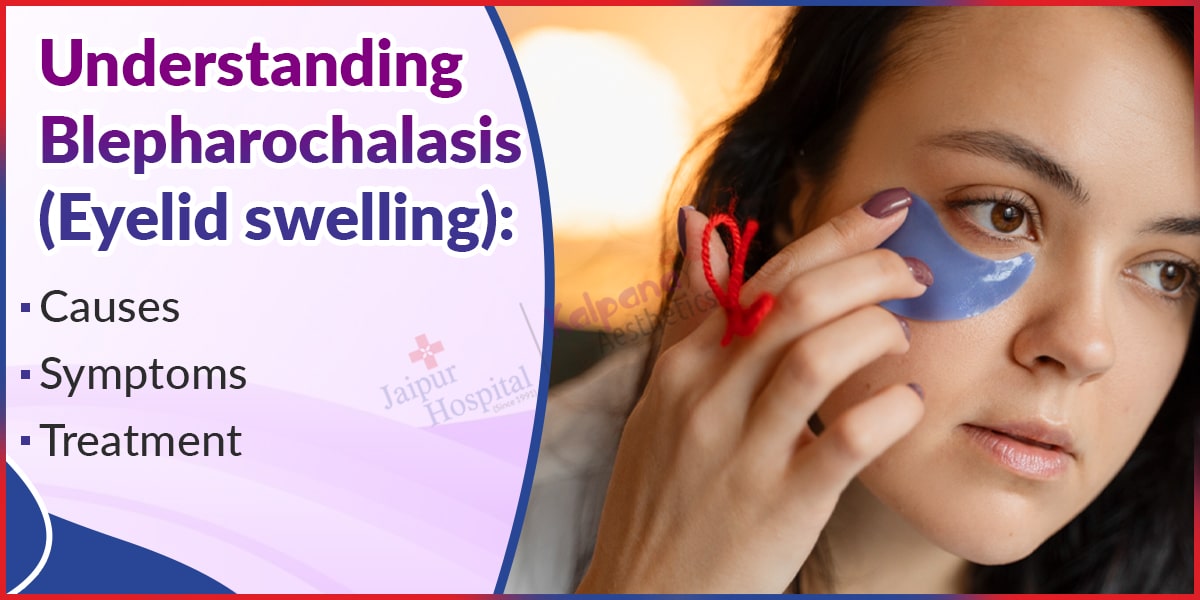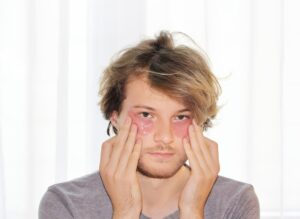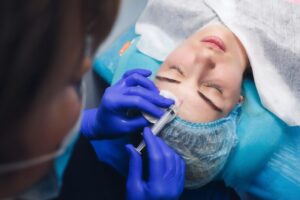Introduction
Rarely encountered and diagnosed, especially when experienced, blepharochalasis manifests as repeated swelling attacks of the eyelid and resultant thinning and wrinkling, followed by sagging of the eyelid skin. This condition is very often mistaken in clinical contexts for other eyelid disorders, but they obviously differ in causal pathways and symptomologies. It is important to understand blepharochalasis to provide treatment options that suit the patient, especially if it interferes with vision or causes cosmetic concerns. Common causes of eyelid swellings will be discussed along with major symptoms of blepharochalasis and its treatment options, including when the surgical route is advised. Ultimately, you will have a clearer understanding of its course and effective ways to manage it.
What is Blepharochalasis?
Blepharochalasis is a rare disorder of the eyelids characterized by recurrent episodes of painless eyelid inflammation and swelling. Ultimately, through repeated swellings, the skin of the upper eyelids is made thin and loose, eventually developing wrinkles that give them a droopy appearance. Normally, the condition is manifested in adolescence or early adulthood and can be unilateral or bilateral. When swelling episodes advance, they cause weakness of the tissues that support the eyelid, thus interfering with vision or the functioning of the eyelid. The causes are yet to be determined, yet the condition of blepharochalasis is found to be induced by localized inflammation or vascular disturbance; hence, understanding its course helps to decide on therapy, whether medical treatment or blepharochalasis surgery.
You Can Read Also:- Lip Lift Surgery: Benefits, Procedure, & Recovery Explained
What are the symptoms of Blepharochalasis?
The symptoms of Blepharochalasis develop gradually and are often confused with puffiness due to aging. Recognizing the specific signs helps in the early diagnosis and treatment of the condition.
Common symptoms are:
- Recurrent eyelid swelling: Sudden, painless swelling comes and goes in the upper eyelids, mostly from teenage years.
- Thin and wrinkled eyelid skin: Repeated inflammation causes the skin to become loose, thin, and crepe-like.
- Drooping eyelids (ptosis): The upper eyelid may sag so much that the person begins experiencing some obscuring of vision.
- Discoloration of eyelid skin: It might take on reddish or dark shades because of chronic inflammation.
- Loss of skin elasticity: The skin of the eyelid becomes loose and therefore gives the appearance of premature aging.
- Asymmetrical appearance: More of one eyelid might be affected than the other, leading to irregularity between both eyes.
What causes Blepharochalasis?
The disease has not yet been fully unraveled, but some think repeated inflammatory processes and necrosis of the eyelid tissues are involved. These recurring episodes bring about changes in the structural properties of the skin and the underlying connective tissue. Here are some common causes of eyelid swelling, which in some etiologic factor or trigger may aggravate the situation of blepharochalasis:
- Localized inflammation: Repeated, mild inflammation of the eyelids over time degrades the elasticity of the skin.
- Vascular instability: Pathological changes may result in fluid leakage and swelling from the small blood vessels of the eyelid.
- Hormonal changes: The onset of the disorder in adolescence suggests a possible role of hormonal variations.
- Genetic predisposition: Some appear to run in families, favoring the concept of inheritance.
- Allergic reactions or infections: These, even though not direct causes, may precipitate an attack of swelling in susceptible individuals.
You Can Read Also:- What Affects the Cost of Plastic Surgery in India?
Treatment Options for Blepharochalasis
Treatment of blepharochalasis depends on the range of symptom severity and how much the condition interferes with vision or aesthetics. Although currently, there are no treatment options to reverse any changes, some approaches can be useful in the management of blepharochalasis, thereby improving the quality of life for patients. The following are commonly opted-for treatment options for blepharochalasis.
- Medical management: Early treatment with anti-inflammatory agents or corticosteroids may allow the reduction of the edema and scarring to prevent.
- Cold compresses during flare-ups: Applying cold packs may be beneficial in reducing eyelid swelling during an active episode.
- Avoiding factors: Some patients may be able to avoid flare-ups by identifying and steering clear of triggers, such as allergens and irritants.
- Surgery for blepharochalasis (blepharoplasty): If the eyelid skin is too droopy or vision is impaired, surgery is usually advised. Skin is removed or tightened, and the eyelid structure is corrected.
- Regular monitoring: Long-term follow-ups with an ophthalmologist will allow monitoring of the progression and of the appropriate time to perform surgery.
Complications if Blepharochalasis Is Left Untreated
If blepharochalasis is under-treated, it will lead to a gradual aggravation of a local condition that could compromise both the appearance and function of the eye. Late-stage, early-phase complaints could be mild or just cosmetic, but others could be very serious and require the following attention:
- Visual Blockage: Excessive laxity of skin on the upper eyelid may start covering the pupil, blocking peripheral or central vision in a far-advanced stage.
- Chronic Eye Irritation: Hanging lax skin may annoy or rub against the eyes, or even cause dryness, since it could interfere with the proper closure of eyelids or blinking.
- Ptosis Development: Gradual weakening of tissues can culminate in true ptosis, where the musculature responsible for raising the eyelid becomes implicated, a condition requiring more involved corrective procedures.Aesthetic
- Considerations: The look of thin, wrinkled eyelids grows more pronounced as time passes, forming a prematurely aged or tired expression, which could contribute to lowered self-esteem.
- An Increased Risk of Eye Infections: Due to the inadequacy of eyelid closure and tear film imbalance, the incipient eyes might be intangibly stirred by bacteria or conjunctivitis.
- Surgical Complexity: Delaying treatment for blepharochalasis, especially when blepharochalasis surgery is eventually needed, may result in more complex or less effective outcomes due to prolonged tissue damage.
Blepharochalasis Surgery (Blepharoplasty)
When blepharochalasis becomes severe enough to affect vision or considerably alter one’s appearance, blepharoplasty is frequently recommended. Surgery is regarded as the best long-term cure for blepharochalasis following the return to the intermission stage in the course of eyelid swelling.
Here is the gist about blepharochalasis surgery:
- What Is Blepharoplasty?
The procedure involves removing excess eyelid skin, tightening loose tissues, and adjusting muscles, if needed, to restore a normal eyelid contour. - In What Cases Is It Performed?
Surgery is typically recommended only once the episodes of swelling have stabilized or stopped to prevent post-surgical relapse. It is best when drooping skin begins to interfere with everyday activities such as reading or driving. - Details of the Procedure:
Usually performed under local anesthesia, it can last up to 1-2 hours, depending on how much work has to be done. The surgeon takes care to remove or reposition tissue without compromising natural eyelid function. - Recovery Time:
Recovery is fairly fast. Swelling and bruising may last from one to two weeks. Most patients resume normal activities within 7–10 days.
● The benefits of the surgery are:
- Improved visual field
- Restored youthful eyelid appearance
- Relief from heaviness or discomfort in the eyelid region
- Improved self-esteem
Prevention and Long-Term Management of Blepharochalasis
While blepharochalasis cannot always be prevented completely, especially when it is due to genetic or inflammatory causes, early recognition and proactive management can decrease the frequency of flare-ups and slow down disease progression. In the long term, attention revolves around the protection of the skin around the delicate eye area, along with symptom management before the symptoms worsen.
Some practical prevention and management strategies here include:
- Avoid known triggers: If a swelling episode is triggered by certain allergens or irritants, avoid such substances in any way possible to keep the eyelid swelling down.
- Utilize cold compresses and keep them applied during episodes of swelling: The coolness will calm inflammation and bring relief during active stages.
- Keep a healthy skincare routine: Wash and moisturize your eyelids with mild and non-irritating products to support skin integrity.
- Avoid excessive use of eyes and prolonged screen-time usage: This may contribute to eye fatigue and puffiness. So, while using digital devices, you can follow the 20-20-20 rule to relieve digital eye stress.
- Eye checkups: Periodic visits with an ophthalmologist or a dermatologist help in observing changes and deciding options of blepharochalasis treatment-including possible blepharochalasis surgery.
- Healthy lifestyle choices: A Healthy diet, good hydration, and smoking prevention help promote skin health and curb inflammation.
- Gentle eye-care habits: Do not rub the eyes or use harsh makeup removers; repeated trauma can make symptoms worse.
Conclusion
Rare, yet the eyelid condition can be of utmost impact if unattended: Blepharochalasis can affect vision and appearance. For its management, one needs to understand symptoms, underlying causes, and treatment options that range from medical therapies to surgery. When treated in the nick of time and well looked after, patients can retain the health of their eyes as well as a good quality of life. The condition is most often, but not always, diagnosed by the specialized Department of Oculoplasty or Cosmetic Eyelid Surgery since surgical precision is an absolute necessity. Kalpana Aesthetics has great merits for offering the best among the eyelid aesthetic and corrective surgery treatments for a patient seeking evaluation and management by an expert.







